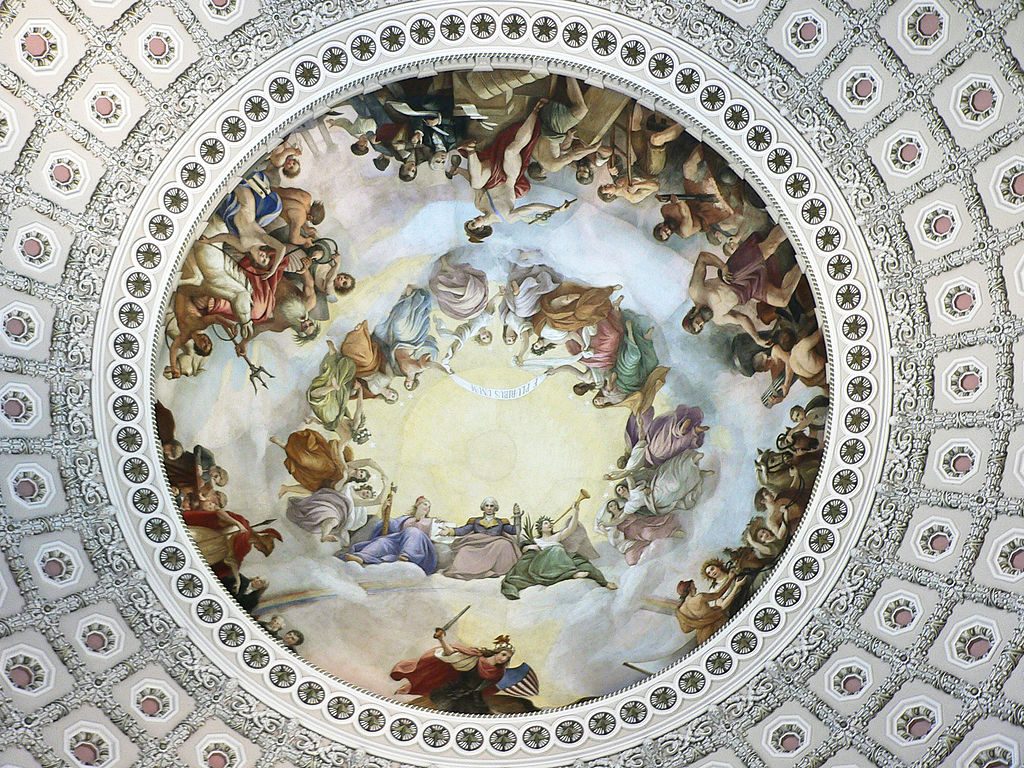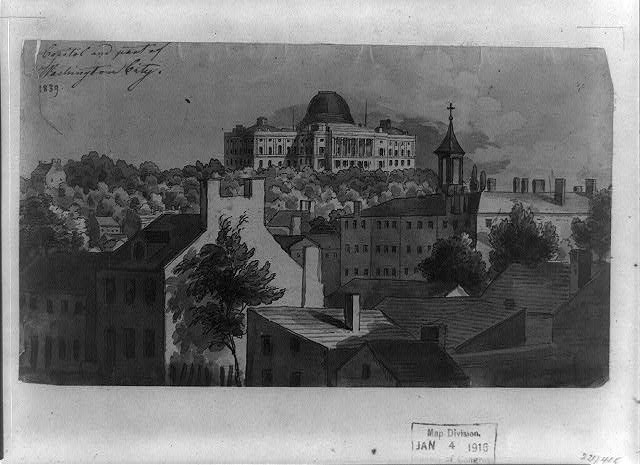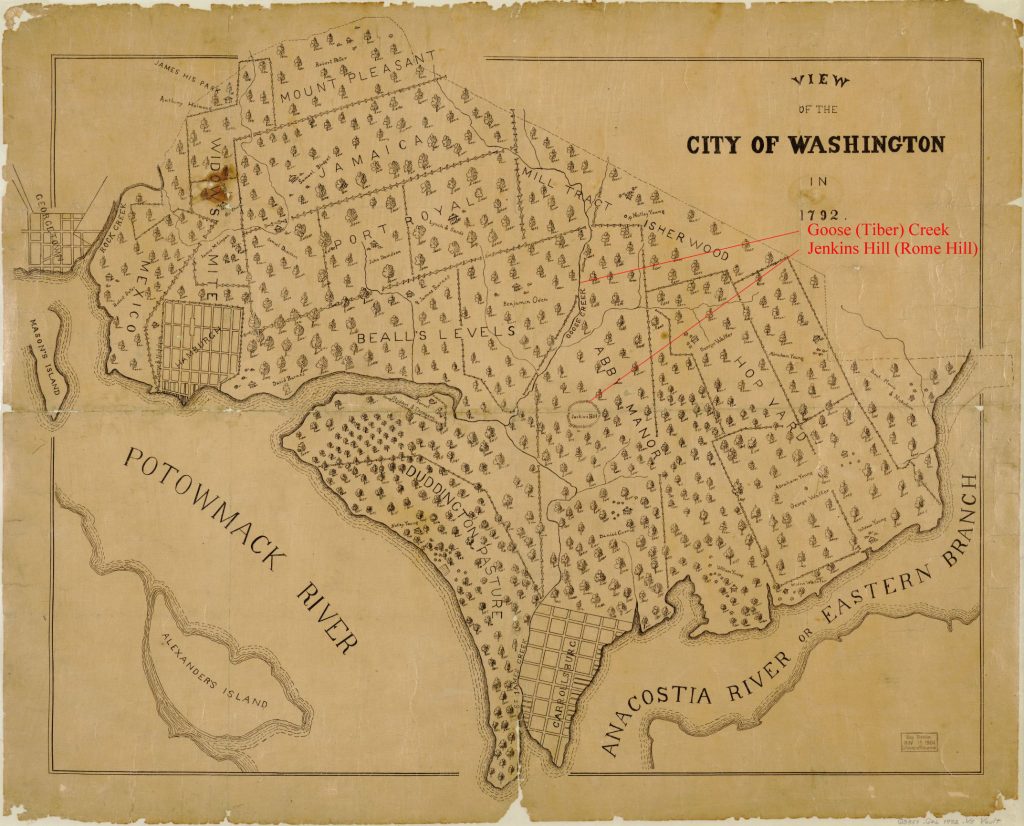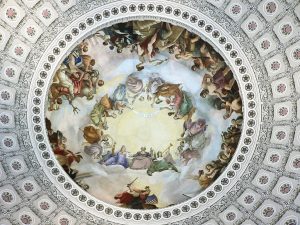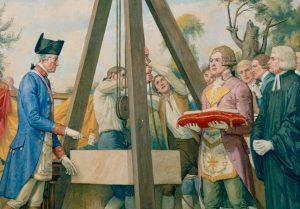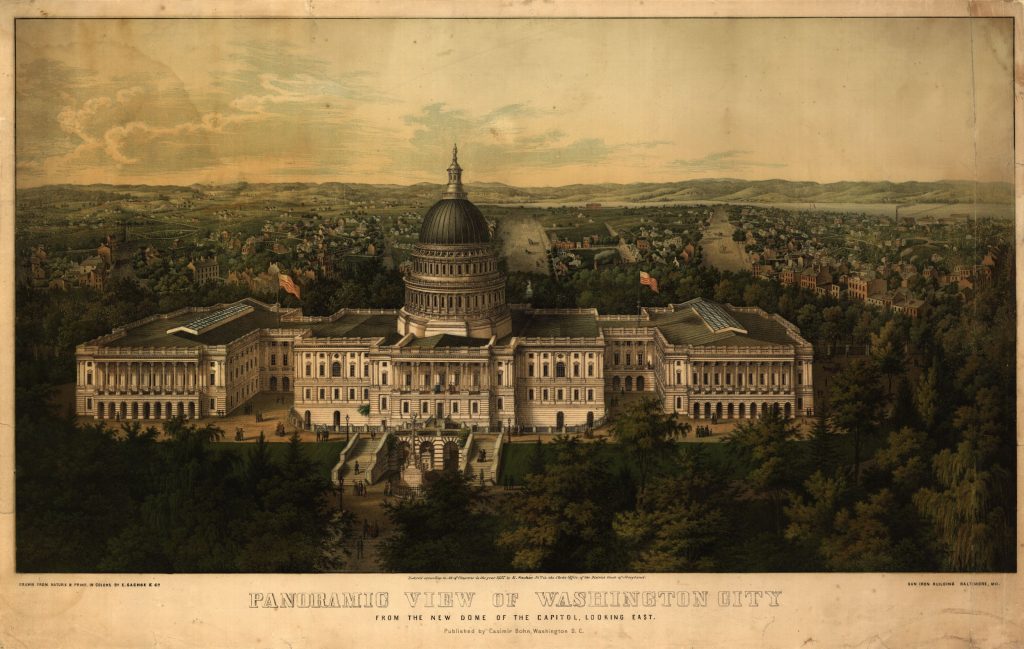I’ve got a challenge for you. How many of you can tell me where the painting headlined in this week’s blog post is found, the name of the man in the purple robes, and the meaning of the painting? I’ll give you a hint. The theme of the painting expresses some of the same symbolism as my last blog post Symbols of the Harlot – Part II.
Before I tell you who and what the painting is about, the history surrounding the painting’s location is another fantastic example of the adage that truth is often stranger than fiction.
Our adventure begins in roughly 509 BC on Capitoline Hill in ancient Rome. That hill, one of ancient Rome’s famous seven hills, was the site of a temple built to honor the Roman god Jupiter. Jupiter, it turns out, was the Roman sky god. Wikipedia provides an enlightening description of this Roman deity:
Jupiter is usually thought to have originated as a sky god. His identifying implement is the thunderbolt and his primary sacred animal is the eagle,[2] which held precedence over other birds in the tking of auspices[3] and became one of the most common symbols of the Roman army (see Aquila). The two emblems were often combined to represent the god in the form of an eagle holding in its claws a thunderbolt, frequently seen on Greek and Roman coins.[4]
As the sky-god, he was a divine witness to oaths, the sacred trust on which justice and good government depend. Many of his functions were focused on the Capitoline Hill, where the citadel was located. He was the chief deity of the early Capitoline Triad with Mars and Quirinus.[5] In the later Capitoline Triad, he was the central guardian of the state with Juno and Minerva. His sacred tree was the oak. (https://en.wikipedia.org/wiki/Jupiter_(mythology))
Did you know that this bit of ancient history is where we get our English word “capital”? The site word-detective.com fills in a few more details.
The ultimate root of both “capital” and “capitol” is, as you note, the Latin “caput,” meaning “head.” “Capitol” with an “o” first appeared in English in the 14th century, derived directly from the Latin word “capitolium” (a derivative of “caput”) which dates all the way back to the Roman Empire.
The Capitolium was the most important temple in Imperial Rome, dedicated to Jupiter Optimus Maximus (the patron god of the Roman Empire) and located at the summit of the Capitoline Hill. While Jupiter was definitely the “head deity” in town, the temple took its name from its location at the top, or “head,” of the hill.
When “capitol” entered English, it was used both in reference to the original Capitolium in Ancient Rome and, more generally, any citadel, castle, etc., at the “head” of a hill. The use of “capitol” to mean a legislative building is an American invention, most likely tied to our historic fondness for Roman architecture in such buildings. “Capitol” was first applied to the legislative chambers in Washington, D.C., by Thomas Jefferson in 1793. (http://www.word-detective.com/2009/03/capitalcapitol/)
Here is where the story gets nearly unbelievable. You see, nearly 2100 years after ancient Rome honored their god Jupiter with a temple on their Capitoline Hill, a devote Catholic named Francis Pope in the mid 1660’s purchased a piece of land in southern Maryland. Maybe because he had a great sense of humor or for some other reason, no one really knows why, but Mr. Pope named a hill on that piece of land, Rome and a stream running through the property which had been named Goose Creek he renamed the Tiber.
Nearly 130 years later, in 1793, Thomas Jefferson, Secretary of State under George Washington renamed Francis Pope’s Rome Hill which in Jefferson’s day was called Jenkins Hill. Wikipedia once again provides the fascinating details:
While serving in 1793 as President George Washington’s Secretary of State, Thomas Jefferson named Capitol Hill, invoking the famous Temple of Jupiter Optimus Maximus on the Capitoline Hill, one of the seven hills of Rome.[4] However, the connection between the two is not completely clear.
Maybe Jefferson knew the history of Rome Hill or maybe he was just conjuring nostalgia of the ancient Roman republic, in any case the name Capitol Hill stuck. And just in case you think I’m pulling your leg with some urban legend the following poem was written by the Irish poet Thomas Moore after visiting Washington, D.C., in 1804.
In fancy, now, beneath the twilight gloom,
Come, let me lead thee o’er the second Rome
Where tribunes rule, where dusky Davi bow,
And what was Goose creek once is Tiber now;
This embryo Capital, where fancy sees
Squares in morasses, oblelisks in trees
Which second-sighted seers, even now adorn
With shrines unbuilt and heroes yet unborn.
By now some of you are probably wondering what this history has to do with the painting at the beginning of this blog post. The reason I shared this bit of unusual history is that it provides a fascinating and what can only be described as a strangely congruent context to the painting. You see, in 1865, seventy two years after George Washington and his Masonic brethren laid the cornerstone of our nation’s Capital on Rome hill, the Greek-Italian artist Constantino Brumidi completed the fresco he was commissioned to paint in the dome of the United States Capitol building on Capitol Hill.
The fresco depicts the apotheosis of George Washington, or in other words the painting represents the deification of our nation’s first president. In the painting Washington is sitting in purple robs between the Goddess Victoria and Liberty with the sun at his back (a point within a circle). Surrounding the sun are 13 maidens which are said to represent the original 13 colonies of the early republic.
It is rather ironic really that George Washington’s apotheosis was depicted in the nation’s capital. If he could, he’d likely be rolling over in his grave at the thought. This was a man so concerned with ensuring that our nation be run as a represented republic that he turned down a request to serve a third term as president, yet here just a generation later he is being depicted as our nation’s first god
I don’t know if paradoxical is the right word, but consider the facts of the matter. George Washington, a man who wouldn’t even consider a third term as president, because he wanted to ensure that no single man became too powerful in the new republic (as opposed to the former Roman republic), is depicted as a god, in a building named after a temple dedicated to Rome’s premier god (Jupiter), a building which he helped dedicate with a cornerstone dated to the Masonic year Anno Lucis 5793 (year of the light), this dedication taking place on a hill once named Rome by a devote Roman Catholic, named Francis Pope.
Stranger than fiction indeed!
There were several reasons I shared this history with you. (Besides the fact that it was fascinating). The apotheosis of Washington is another example of the humanist belief in the deification of man outside YHWH’s reconciliation provided by Yeshua. That George Washington was used as the subject of this apotheosis is just a clever way for Constantino Brumidi to disguise a bit of ancient paganism with a cloak of Washingtonian respectability. As discussed in the last article, the Washington Monument was another example of such a clever disguise.
If you are thinking this a bit too much to be a coincidence then consider the words of Albert Pike as quoted by Charles S. Lobinger, in the History of the Supreme Council of the Southern Jurisdiction [Freemasonry]p. 244 )
“Masons do not build monuments to [George] Washington, and plume themselves on the fact that he was a Mason merely on account of his Masonic virtues. It is because his civic reputation sheds glory upon the Order.”
So there you have it. Washington’s name wasn’t used in these iconic American monuments only because of his Masonic qualifications, but rather he had such a great reputation that it conferred respectability upon the Masonic order and their underlying religious beliefs. That this clever deception worked is evidence by the fact that today, many intelligent and well-meaning Christians consider monuments such as the Washington Monument or paintings such as the Apotheosis of Washington evidence of our nation’s Christian heritage, when in fact these examples provide a sobering counterbalance to those claims.
Today there are two extremes when looking our nation’s founding and men and women involved in it. One side claims America was founded as an entirely Christian nation by men and women with strong Christian beliefs. The other side claims most of those same men and women were Deists, Gnostics, and Atheists who only paid lip service to Christianity out of political expediency because Christianity, in one form or another, was the predominate religion of America’s early settlers.
The truth of the matter is that our history is a lot more complicated than that. George Washington for example, was profoundly aware of the necessity of founding our government upon Judeo-Christian values because he understood that any form of government not anchored in divine law could not function in a manner which best served the people. Divine law resides outside the constructs of man, thus (in theory) it cannot be modify or changed to fit the lusts of mankind.
George Washington was a human being just like the rest of us. He had associations, responsibilities, and weaknesses which conspired to undermine the vision he had for this nation. As we’ve seen, his masonic associations are just one example what happens when any of us allow the adversary a foothold in our lives. In Washington’s day Masonry was an incredibly influential ally and it is doubtful that he could have accomplished all that he did without their succor and support. It is also apparent from Washington’s Masonic Correspondence and other historical evidence that he seldom attended lodge meetings and that he had an incomplete knowledge of Masonic affairs. In fact, just a few months before his death, George Washington, being convinced of the danger of secret societies by John Adams (who opposed Freemasonry), used his influence to warn of the dangers secret societies posed to our nation. Unfortunately, as history records, it appears his warning was too little, too late.
Works of Darkness
As I’ve tried to show in these articles, Satan’s humanist lie in Eden hasn’t changed. Since that fateful day long ago mankind has been infected with the belief that by our own efforts we can achieve immortality. The fresco painted by Constantino Brumidi is just one more example.
I do believe America has roots in Judeo-Christian principles, but I also believe that early on during our nation’s founding tares were also sown and those tares have grown to maturity in our generation. As Christians first and Americans second, stewardship demands we not sit idly by as the darkness closes in around us. We must share the light of truth. Paul’s words to the Ephesians seem especially appropriate here:
For ye were sometimes darkness, but now are ye light in the Lord: walk as children of light: (For the fruit of the Spirit is in all goodness and righteousness and truth;) Proving what is acceptable unto the Lord.
And have no fellowship with the unfruitful works of darkness, but rather reprove them. For it is a shame even to speak of those things which are done of them in secret. But all things that are reproved are made manifest by the light: for whatsoever doth make manifest is light.
Wherefore he saith, Awake thou that sleepest, and arise from the dead, and Christ shall give thee light. See then that ye walk circumspectly, not as fools, but as wise, Redeeming the time, because the days are evil. Wherefore be ye not unwise, but understanding what the will of the Lord is. (Ephesians 5:8-17)
Whose “light” are you following?
Part IV – Symbols of the Harlot
I had intended to also write this week about the Great Seal of the United States and its masonic symbolism in an effort to separate the fact from the conspiratorial fiction, but this article was a bit longer than intended, so YHWH willing next time we will explore that fascinating history and symbolism in the light of Biblical truth.
I hope you’ll join the adventure…
The Mystery Babylon Series
Part 1 The Mother of Harlots
Part 2 The Religion of the Harlot
Part 3 Babylon and the Harlot
Part 4 Conspiracies of the Harlot – Part I
Part 5 Conspiracies of the Harlot – Part II
Part 6 Symbols of the Harlot – Part I
Part 7 Symbols of the Harlot – Part II
Part 8 Symbols of the Harlot – Part III
Part 9 Symbols of the Harlot – Part IV
Part 10 Symbols of the Harlot – Part V
Part 11 Homo Deus
* * *

